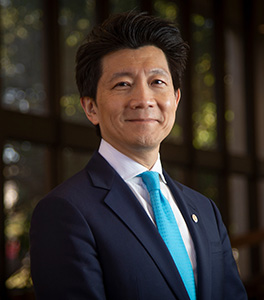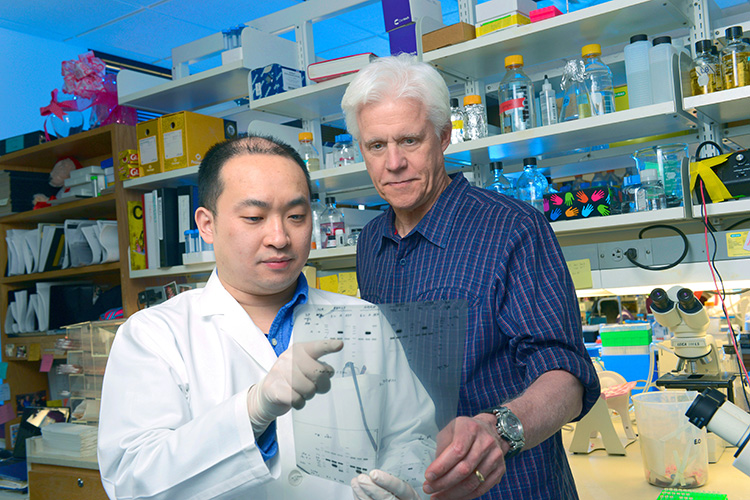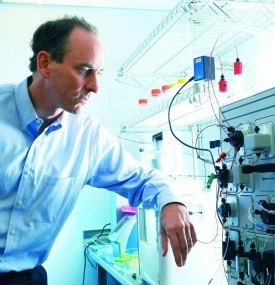Dauer shares team-based vision for O'Donnell Brain Institute growth

The renowned scientific culture at UT Southwestern was a major attraction for Dr. William T. Dauer, an acclaimed physician-investigator in dystonia and Parkinson’s disease who was recruited in a national search to become the inaugural Director of the Peter O’Donnell Jr. Brain Institute.
But it was the deep commitment of UT Southwestern’s leadership and community supporters to create a leading center for the study and treatment of brain disease that convinced Dr. Dauer of the unprecedented opportunity before him.
The commitment of both the University and the surrounding community, with Mr. Peter O’Donnell at the forefront, is really unparalleled in any environment I know of,
Dr. Dauer said. The dedication to make this an important priority – not just for one, two, or three years but for the enduring future – to change the lives of people with brain disease, I think will be the key ingredient for success.
"There have been a number of very important advances in the last decade that are helping us understand how the brain works and also how diseases disrupt that function, which gives us key clues to devise therapies to either lessen suffering or to prevent it altogether."
Dr. Dauer joined UT Southwestern as Director of the O’Donnell Brain Institute and Professor of Neurology and Neurotherapeutics and Neuroscience on July 1. In the new role, he is responsible for integrating the work of scientists and clinicians in fields that include neurology, neuroscience, neurosurgery, physical medicine and rehabilitation, neuroradiology, and psychiatry.

Dr. Dauer’s arrival on campus marks a significant milestone for the O’Donnell Brain Institute, which aims to accelerate discoveries into the underlying causes of brain disorders by facilitating synergies across many disciplines,
said Dr. W. P. Andrew Lee, Executive Vice President for Academic Affairs, Provost, and Dean of UT Southwestern Medical School. The recent groundbreaking for a new Research Tower for the O’Donnell Brain Institute on North Campus and the ongoing expansion of William P. Clements Jr. University Hospital, where the new third tower will serve as the O’Donnell Brain Institute’s clinical home, represent UT Southwestern’s commitment to the study and treatment of brain diseases, the last frontier in medicine.
Dr. Dauer came to UT Southwestern from the University of Michigan, where he was Director of the Movement Disorders Group and Director of the Morris K. Udall Center of Excellence for Parkinson’s Disease Research.
Building teams across disciplines, among both scientists and clinicians, will be a key focus of the O’Donnell Brain Institute as it seeks to uncover the fundamental causes of brain disease and translate discoveries into treatments.
UT Southwestern has a uniquely outstanding scientific culture,
Dr. Dauer said. It’s really the perfect place to bring together the best minds in the country, or even the world, to work on brain science with the important goal of improving the lives of people with brain diseases.
In an interview during his first week on campus, Dr. Dauer shared his thoughts about the O’Donnell Brain Institute’s mission and the future of brain science.
What are your priorities as Director of the O’Donnell Brain Institute?
The long-term priority is to be the leading center for caring for people with brain disease, including both neurologic and psychiatric illness.
In the short term, there are really three pillars, each of which is essential to meet our long-term goal. One is creating outstanding clinical care, with teams of individuals who talk to each other to provide integrated care for patients. Integrated care means that when a patient with a neurologic or psychiatric disease comes to a clinic, they won’t just see a physician and then go back and forth to see all the ancillary people who are important to their care. A variety of services will be co-located; so, for example, a physician, social worker, and physical therapist will work together to build the best plan for the patient.
"It’s important to understand that science is increasingly a team effort. Many scientific disciplines have grown up and are sufficiently sophisticated that it’s impossible for one person to figure it all out."
The second pillar is harnessing the tremendous scientific excellence of UT Southwestern, ranging from molecular to behavioral to human subject investigation. We will nucleate groups of the best scientists in the world to tackle key areas that are ripe for human translation. This will include scientists who will be located in the new O’Donnell Brain Institute Research Tower as well as a vigorous effort to create an exemplary clinical trials unit that will allow us to be a magnet for human subject research, including “first-in-brain” human studies.
The third pillar, which really will enable the other two, is to enrich the tremendous scientific community that already exists here to amplify brain research. That will include efforts to recruit key faculty in areas that are primed for advancement, as well as attracting and supporting the best trainees to neuroscience and brain disease studies. We’ll focus on the people who are working today, but this is a large problem and so we also need to build the best minds for tomorrow.
What progress is being made in brain science and why are you optimistic that there will be significant breakthroughs?
This is a tremendously exciting time for brain science. There have been a number of very important advances in the last decade that are helping us understand how the brain works and also how diseases disrupt that function, which gives us key clues to devise therapies to either lessen suffering or to prevent it altogether.
One of the exciting advances has been to use new neuroimaging techniques to look inside the brain, both in humans and animals in experimental research. Related to that are a suite of new tools that allow us to manipulate specific sets of brain cells. For example, in Parkinson’s, there are a few particular sets of brain cells out of billions that are really key to producing the symptoms. The ability to study those in isolation is something new that could never be done before.

Similarly, there are new techniques that allow us to deliver proteins or genes into the nervous system in a highly focused way. In recent years, a retinal disease that causes blindness and a neuromuscular disease that causes death in infancy have been dramatically changed or sometimes cured with gene therapy. In fact, some of the most exciting work in Duchenne muscular dystrophy is happening here at UT Southwestern, led by Dr. Eric Olson, Chair of Molecular Biology and Director of the Hamon Center for Regenerative Science and Medicine.
Ultimately, we want to prevent the onset of disease and not have to deal with symptoms later. An essential element of the O’Donnell Brain Institute and cause for great excitement is the understanding of the fundamental molecular features of brain disease. In neurodegenerative disease in particular, there have been fundamental advances over the last 10 years, as exemplified by the work of Dr. Marc Diamond with Alzheimer’s disease, where we are beginning to understand how molecules can take on a different shape, become toxic, and harm brain cells.

There is a lot of talk about creating synergies within the O’Donnell Brain Institute. What does that mean?
It’s important to understand that science is increasingly a team effort. Many scientific disciplines have grown up and are sufficiently sophisticated that it’s impossible for one person to figure it all out. What we need to do is assemble groups of people with varying expertise – in basic molecular function, in brain circuit function, in computing – to work together on common problems of brain function and health.
Similarly, in the clinical arena the key goal will be to create integrated care, where a variety of services, including research, will be co-located so the patient is cared for by a team. The key is to provide not only the best care for the patient but to build systems that optimize the patient experience and allow them to access care in the most efficient way possible.
Dr. Dauer holds the Lois C.A. and Darwin E. Smith Distinguished Chair in Neurological Mobility Research.
Dr. Diamond, Director of the Center for Alzheimer’s and Neurodegenerative Diseases, holds the Distinguished Chair in Basic Brain Injury and Repair.
Dr. Lee holds the Atticus James Gill, M.D. Chair in Medical Science.
Dr. Olson holds the Pogue Distinguished Chair in Research on Cardiac Birth Defects, The Robert A. Welch Distinguished Chair in Science, and the Annie and Willie Nelson Professorship in Stem Cell Research.

